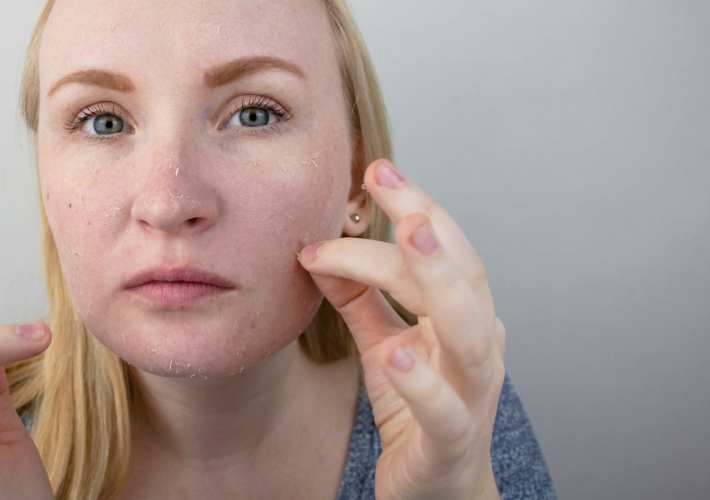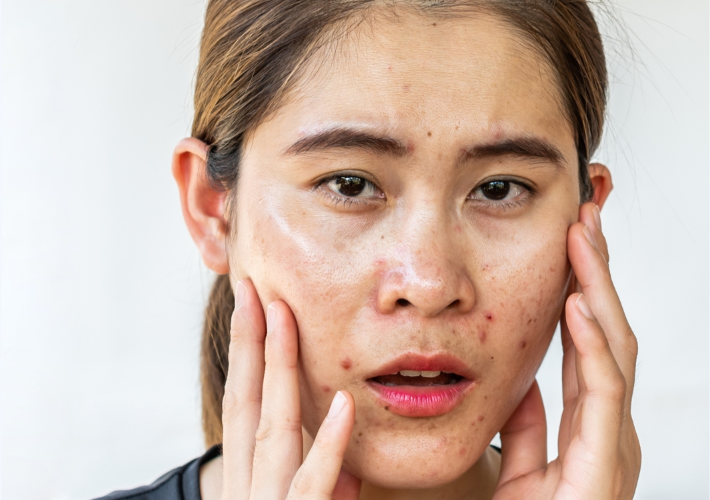
Your skin is unique, and understanding its specific needs is key to achieving a healthy and radiant complexion. In this guide, we will delve into the different skin types – Normal, oily, dry, combination, and sensitive – providing you with valuable insights into their characteristics and how to care for them. Whether you’ve always wondered why your T-zone tends to get shinier or why certain products cause redness and irritation, we have the answers you’ve been searching for.
Our team of skincare experts will share tips and tailored recommendations to help you develop a skincare routine that addresses the specific needs of your skin type. From cleansers and moisturizers to serums and masks, we will guide you through the vast landscape of skincare products to ensure you make informed choices that promote optimal skin health.
Start your day with a tailored morning skincare routine to ensure your skin remains balanced and glowing throughout the day.
Unlock the secrets to healthy and glowing skin as we embark on a journey to uncover the unique traits of different skin types and empower you to nurture your skin’s natural beauty.
Identifying Your Skin Type

Determining your skin type is the first step in developing an effective skincare routine. Knowing whether your skin is oily, dry, combination, or sensitive can help you tailor your products and techniques to address your specific needs. To identify your skin type, consider the following factors:
1. Sebum Production
Oily skin produces an excess of sebum, leading to a shiny or greasy appearance, especially in the T-zone (forehead, nose, and chin). Dry skin, on the other hand, lacks sufficient sebum production, resulting in a tight, flaky, or dull complexion. Normal skin has a balanced sebum level, with a smooth, even texture.
2. Pore Size
Oily skin typically has larger, more visible pores, while dry skin often has smaller, less noticeable pores. Normal skin has pores that are neither too large nor too small.
3. Sensitivity
Sensitive skin is prone to redness, irritation, and reactions to certain ingredients or environmental factors. Dry skin may also feel sensitive due to a compromised skin barrier. Normal skin is generally less reactive and can tolerate a wider range of products.
4. Hydration Level
Dry skin feels tight and lacks moisture, while oily skin may feel greasy or shiny. Normal skin has a healthy, balanced hydration level.
Once you’ve identified your skin type, you can begin tailoring your skincare routine to address its specific needs. Remember, your skin type can also change over time due to factors like age, hormones, and environmental conditions, so it’s important to regularly reassess and adjust your regimen accordingly.
If you’ve noticed persistent redness or irritation, it might be worth considering finding a good dermatologist to help you identify your skin type and address specific concerns.
Normal Skin: Characteristics and Care Tips

Normal skin is often considered the “ideal” skin type, as it exhibits a healthy balance of sebum production, hydration, and sensitivity. Individuals with normal skin typically enjoy a smooth, even complexion with minimal blemishes or concerns.
Characteristics of Normal Skin
- Balanced sebum production, neither too oily nor too dry
- Small, barely visible pores
- Minimal sensitivity or reactivity to skincare products
- Supple, radiant, and youthful appearance
- Able to maintain a healthy moisture level without excessive dryness or oiliness
Care Tips for Normal Skin
While normal skin may not require as much attention as other skin types, it’s still important to maintain a consistent and gentle skincare routine. Here are some tips for caring for normal skin:
- Cleanse Gently: Use a mild, non-foaming cleanser to remove impurities without stripping the skin of its natural oils. Avoid harsh scrubs or exfoliants that can disrupt the skin’s delicate balance.
- Moisturize Regularly: Apply a lightweight, oil-free moisturizer to keep the skin hydrated and supple. Look for formulas that contain nourishing ingredients like hyaluronic acid, glycerin, or ceramides.
- Protect from Sun Damage: Normal skin can still be susceptible to the harmful effects of UV radiation. Incorporate a broad-spectrum sunscreen with an SPF of 30 or higher into your daily routine to prevent premature aging and discoloration.
- Incorporate Antioxidants: Adding antioxidant-rich serums or treatments to your regimen can help neutralize free radicals and support the skin’s natural defense mechanisms, promoting a healthy, glowing complexion.
By following these simple yet effective tips, you can maintain the healthy, balanced appearance of normal skin and prolong its youthful radiance.
For those with normal skin, occasional treatments like different types of chemical peels can enhance your skin’s natural radiance and keep your complexion smooth.
Dry Skin: Characteristics and Care Tips

Dry skin is characterized by a lack of sufficient sebum production, leading to a tight, flaky, and dull complexion. Individuals with dry skin often struggle with increased sensitivity, irritation, and visible signs of aging.
Characteristics of Dry Skin
- Tight, rough, or scaly texture
- Visible fine lines and wrinkles
- Increased sensitivity and reactivity to certain ingredients
- Dull, lackluster appearance
- Prone to redness, itchiness, and discomfort
Care Tips for Dry Skin
Caring for dry skin requires a focused approach to replenish and maintain the skin’s natural moisture levels. Here are some tips to help nourish and hydrate dry skin:
- Cleanse Gently: Choose a creamy, non-foaming cleanser that won’t strip the skin of its natural oils. Avoid harsh, drying soaps and opt for gentle, moisturizing formulas instead.
- Exfoliate Cautiously: Dry skin can benefit from gentle exfoliation to remove flaky, dead skin cells, but be sure to use a soft, hydrating scrub or chemical exfoliant (such as alpha hydroxy acids) no more than 1-2 times per week.
- Moisturize Intensely: Incorporate a rich, creamy moisturizer that contains nourishing ingredients like shea butter, ceramides, and hyaluronic acid. Apply the moisturizer immediately after cleansing to lock in hydration.
- Use Occlusive Barriers: Applying a facial oil or balm as the last step in your routine can help seal in moisture and create a protective barrier against environmental stressors.
- Hydrate from Within: Drinking plenty of water and incorporating hydrating, omega-rich foods into your diet can help support the skin’s natural moisture levels from the inside out.
By following these dry skin care tips, you can restore the skin’s suppleness, reduce the appearance of fine lines and wrinkles, and achieve a healthy, radiant glow.
Oily Skin: Characteristics and Care Tips

Oily skin is characterized by an overproduction of sebum, leading to a shiny, greasy appearance, enlarged pores, and an increased risk of acne breakouts. Individuals with oily skin often struggle with managing the excess oil and keeping their complexion looking fresh and matte.
Characteristics of Oily Skin
- Shiny, greasy appearance, especially in the T-zone (forehead, nose, and chin)
- Enlarged, visible pores
- Prone to blackheads, whiteheads, and acne breakouts
- Thicker skin texture
- Resistance to moisturizers and hydrating products
Care Tips for Oily Skin
Caring for oily skin requires a delicate balance of controlling excess oil production while maintaining the skin’s natural moisture levels. Here are some tips to help manage oily skin:
- Cleanse Thoroughly: Use a gentle, foaming cleanser or a clay-based wash to remove excess oil, dirt, and impurities from the skin. Avoid over-cleansing, as this can stimulate the skin to produce even more sebum.
- Mattify with Oil-Absorbing Products: Incorporate oil-blotting sheets, mattifying powders, or mattifying moisturizers into your routine to help control shine and keep the skin looking matte throughout the day.
- Exfoliate Regularly: Gently exfoliate 1-2 times per week using a chemical exfoliant (such as salicylic acid or glycolic acid) to unclog pores and prevent the buildup of dead skin cells.
- Use Non-Comedogenic Products: When selecting skincare and makeup products, look for non-comedogenic formulas that won’t clog your pores and contribute to breakouts.
- Hydrate Wisely: Oily skin still requires hydration, but opt for lightweight, oil-free moisturizers that won’t leave the skin feeling greasy. Incorporate hydrating serums with ingredients like hyaluronic acid to quench the skin without adding excess oil.
By following these oily skin care tips, you can achieve a balanced, matte complexion that is less prone to acne and other oil-related concerns.
To manage excess oil and prevent breakouts, consider incorporating various types of microneedling into your skincare routine for targeted results.
Combination Skin: Characteristics and Care Tips

Combination skin is a unique skin type that exhibits characteristics of both oily and dry skin, typically with a shiny T-zone and drier cheeks and outer areas. Managing combination skin can be a delicate balancing act, but with the right approach, you can achieve a healthy, radiant complexion.
Characteristics of Combination Skin
- Oily T-zone (forehead, nose, and chin) and drier cheeks and outer areas
- Enlarged pores in the T-zone
- Prone to blackheads and blemishes in the oily areas
- Visible fine lines and dryness in the drier areas
- Uneven skin texture and tone
Care Tips for Combination Skin
Caring for combination skin requires a tailored approach that addresses the specific needs of both the oily and dry areas. Here are some tips to help you manage your combination skin:
- Cleanse Strategically: Use a gentle, non-foaming cleanser on the drier areas and a deeper-cleansing formula (such as a clay-based or salicylic acid-infused wash) on the oily T-zone to remove excess oil and impurities.
- Exfoliate Selectively: Exfoliate the oily areas 1-2 times per week using a chemical exfoliant, while using a gentler, hydrating scrub on the drier regions to prevent further dryness.
- Moisturize Accordingly: Apply a lightweight, oil-free moisturizer to the T-zone and a richer, more nourishing formula to the cheeks and outer areas. You can also use a hydrating serum on the drier regions to boost moisture levels.
- Blot and Mattify: Use oil-blotting papers or a translucent powder to control shine in the T-zone throughout the day, while avoiding over-powdering the drier areas.
- Introduce Targeted Treatments: Consider using a spot treatment containing salicylic acid or benzoyl peroxide on blemishes in the oily areas, while applying a hydrating mask or facial oil to the drier regions.
By tailoring your skincare routine to address the unique needs of both the oily and dry areas, you can achieve a balanced, radiant complexion with combination skin.
Sensitive Skin: Characteristics and Care Tips

Sensitive skin is characterized by a heightened reactivity to various environmental factors, skincare ingredients, and external stressors. Individuals with sensitive skin often experience redness, irritation, and discomfort, making it challenging to find products and routines that work effectively without causing further distress.
Characteristics of Sensitive Skin
- Easily irritated by certain ingredients, environmental factors, or changes in routine
- Prone to redness, stinging, itching, or burning sensations
- May experience dryness, flakiness, or tightness
- Increased susceptibility to skin conditions like eczema or rosacea
- Difficulty tolerating certain cosmetic procedures or treatments
Care Tips for Sensitive Skin
Caring for sensitive skin requires a gentle, soothing approach that avoids further irritation. Here are some tips to help you nurture your sensitive skin:
- Cleanse Gently: Choose a mild, fragrance-free cleanser that won’t strip the skin of its natural oils. Avoid harsh scrubs, exfoliants, and foaming formulas, as they can disrupt the skin’s delicate barrier.
- Moisturize Thoughtfully: Opt for a fragrance-free, hypoallergenic moisturizer that contains calming, nourishing ingredients like ceramides, glycerin, and aloe vera. Avoid products with potential irritants like alcohol, fragrances, and harsh preservatives.
- Protect from the Elements: Incorporate a broad-spectrum, mineral-based sunscreen into your daily routine to shield your skin from the damaging effects of UV radiation, which can exacerbate sensitivity.
- Introduce Soothing Ingredients: Look for skincare products infused with calming botanicals like chamomile, green tea, or centella asiatica, which can help reduce redness and inflammation.
- Avoid Harsh Treatments: Steer clear of aggressive exfoliants, retinoids, and cosmetic procedures that may cause further irritation. Instead, focus on gentle, restorative treatments that strengthen the skin’s barrier.
By following these sensitive skin care tips and being mindful of your skin’s unique needs, you can effectively manage and soothe your sensitive complexion, promoting a healthy, radiant glow.
Before trying treatments like microneedling, ensure your skin can tolerate them by consulting with experts; you can book now for microneedling spa sessions tailored to sensitive skin.
Conclusion
Understanding your skin type is essential for crafting a skincare routine that truly meets its needs. Whether your skin is oily, dry, normal, combination, or sensitive, each type requires specific care and attention to maintain a healthy, radiant complexion. By identifying your skin’s unique characteristics and following tailored care tips, you can enhance its natural beauty and address any concerns effectively. Remember, your skin’s needs may change over time, so continue to reassess and adjust your routine to ensure your skin stays glowing and healthy.
Whether you have oily, dry, or combination skin, Arlington’s skincare clinic offers tailored solutions to help you achieve a radiant complexion.
